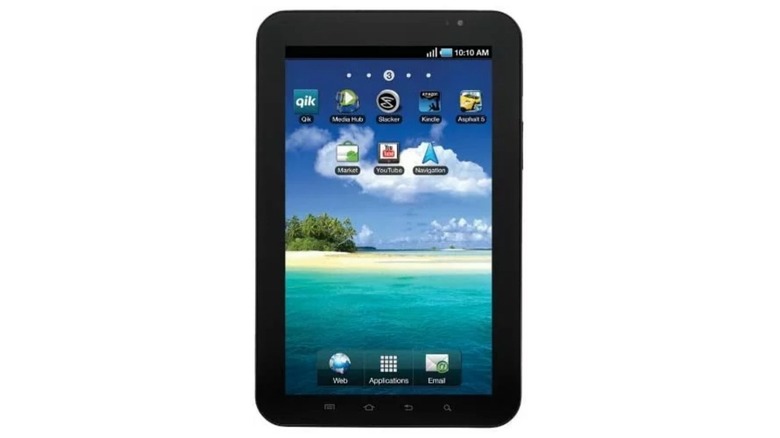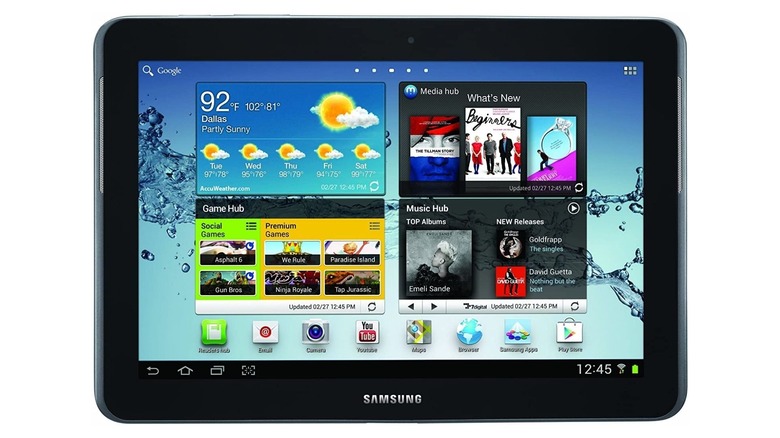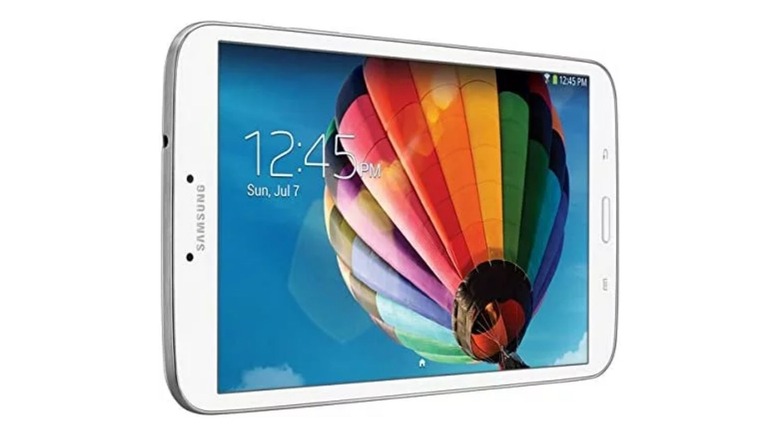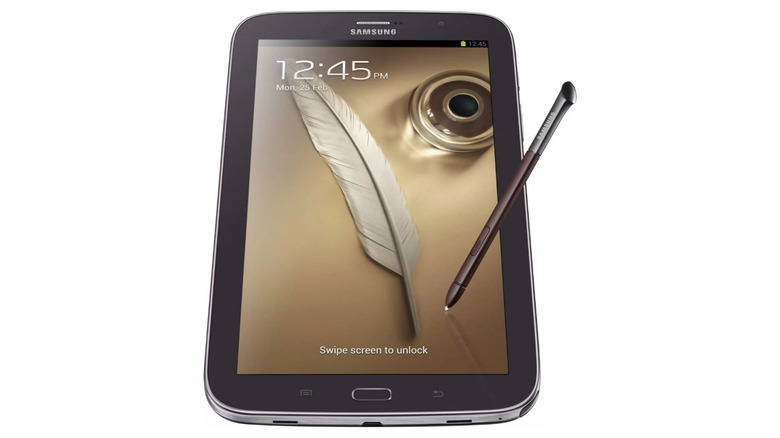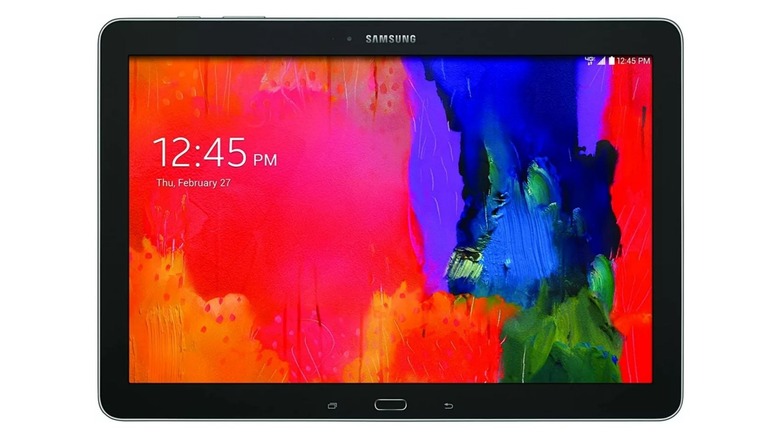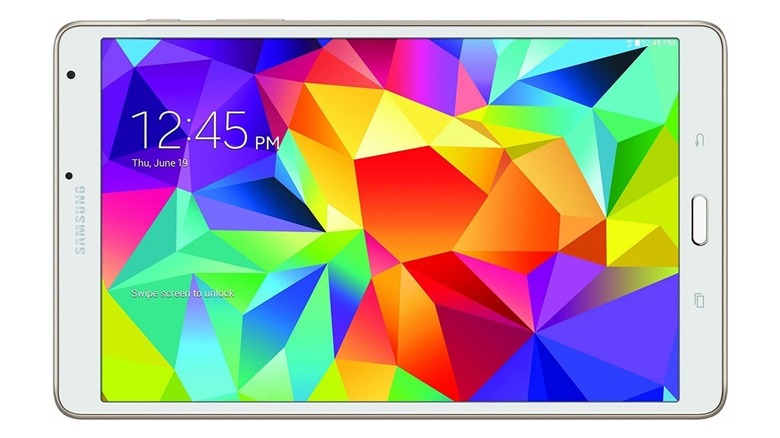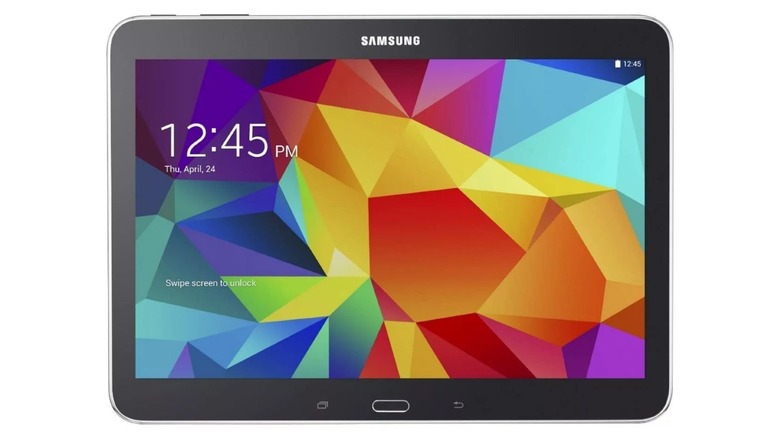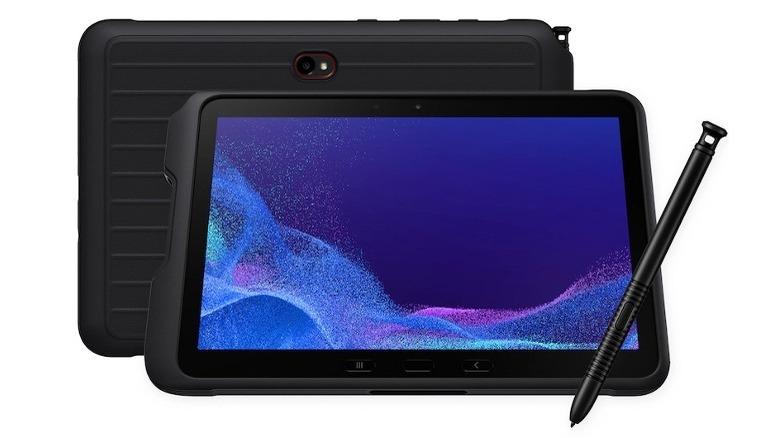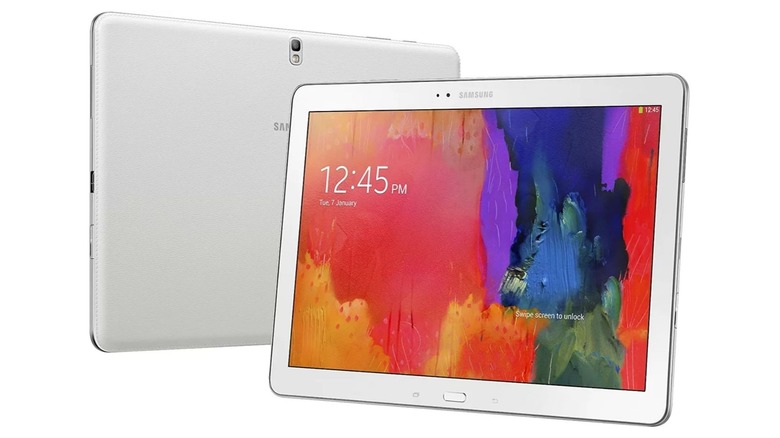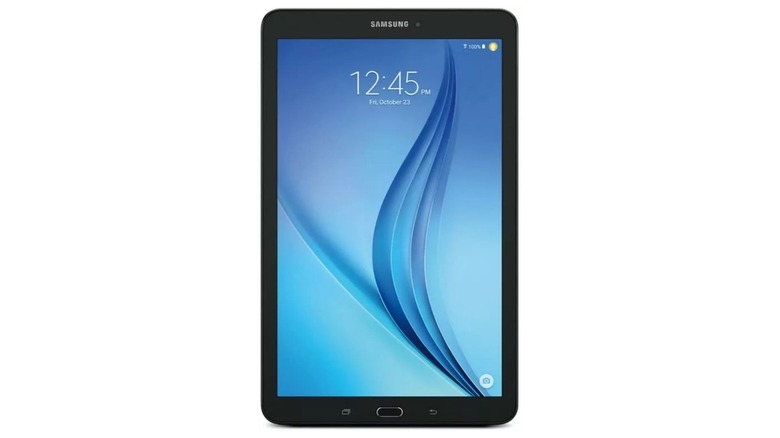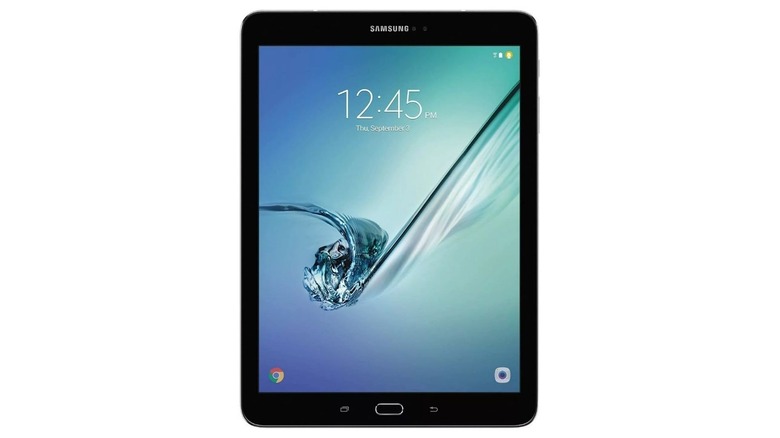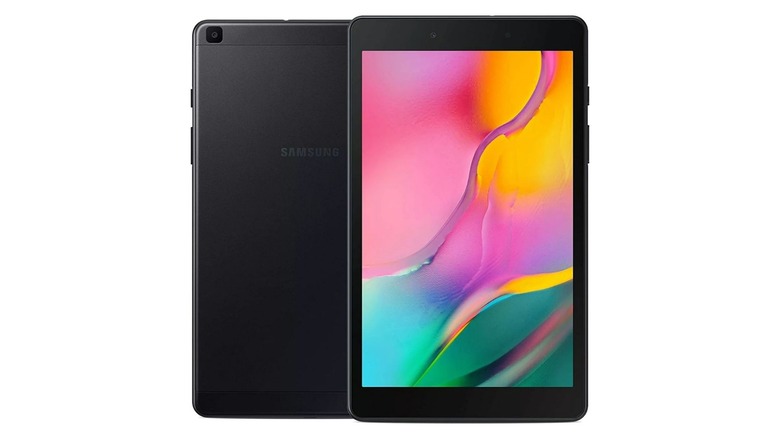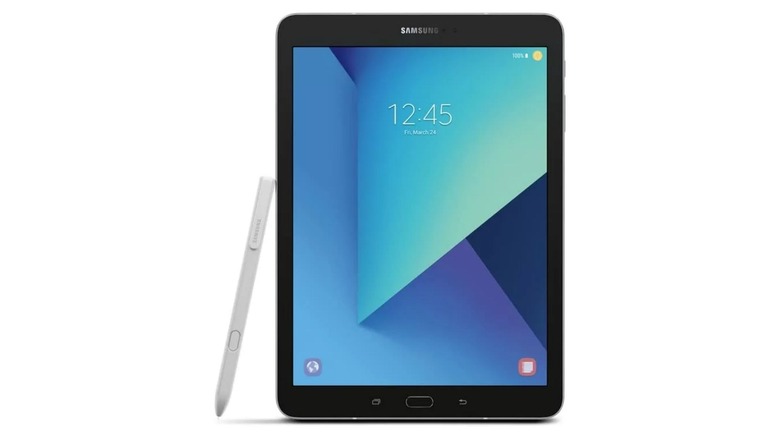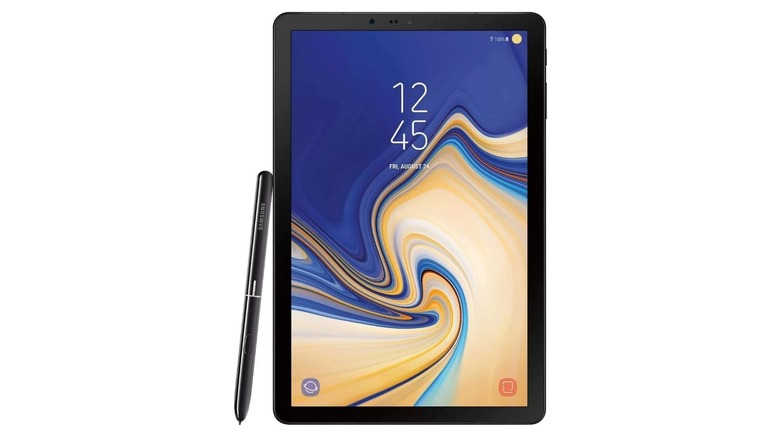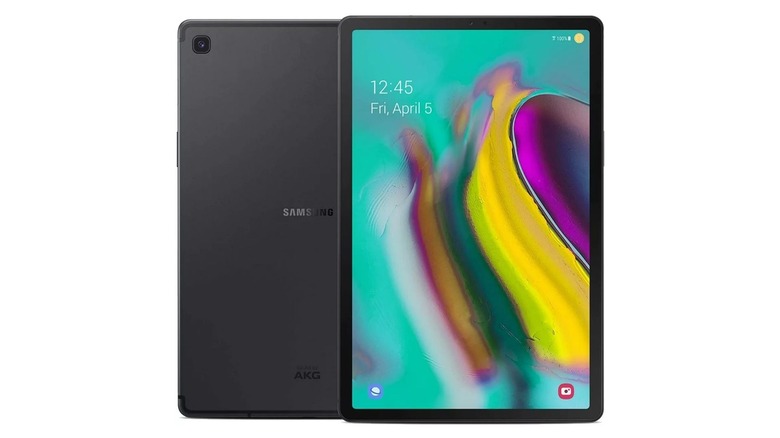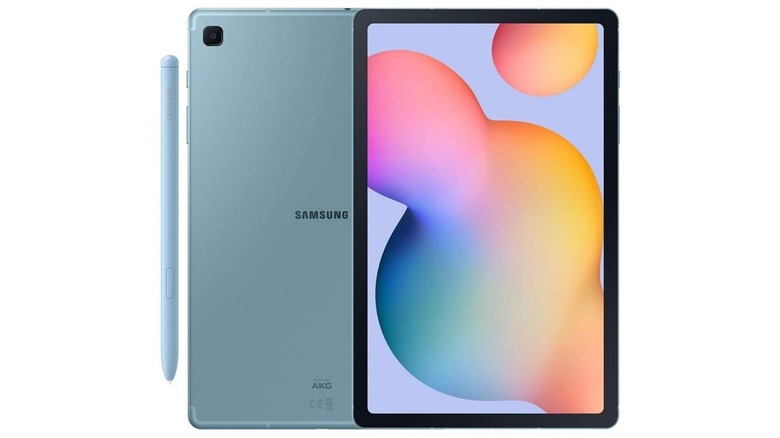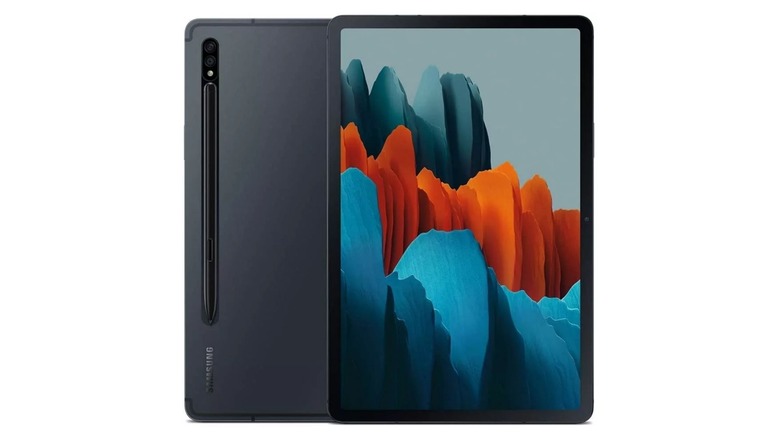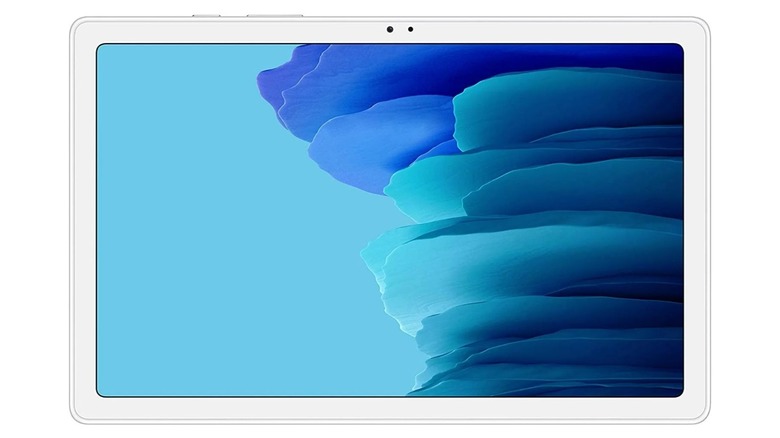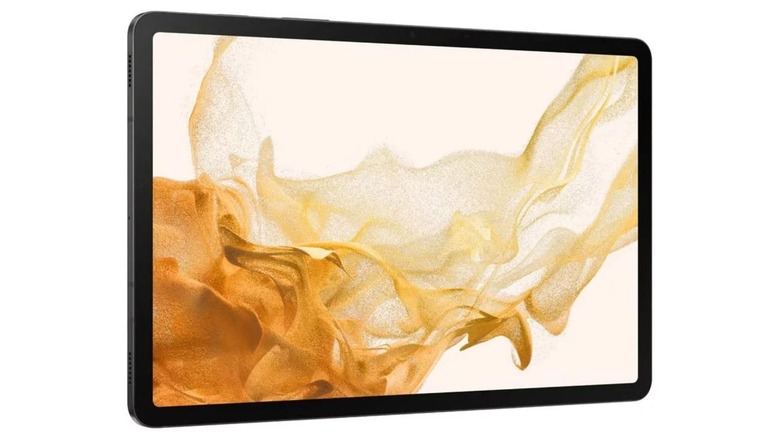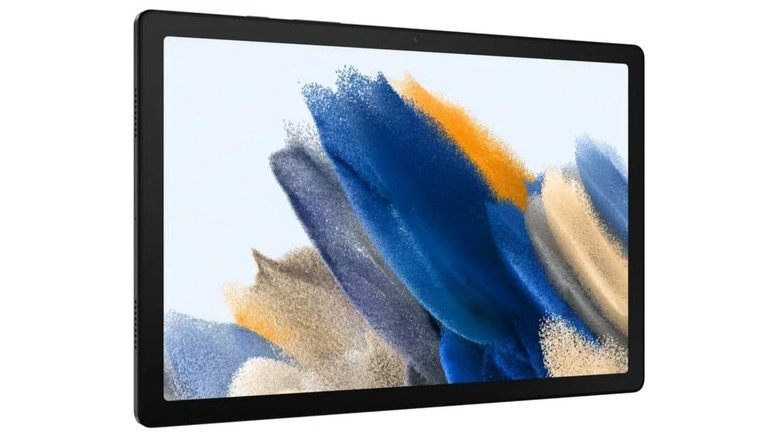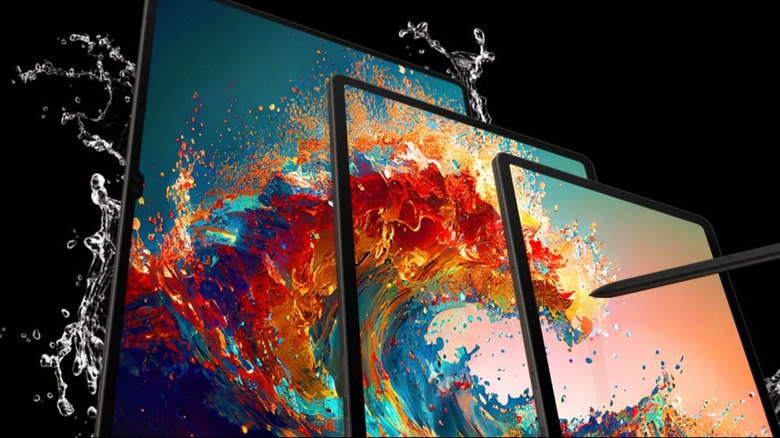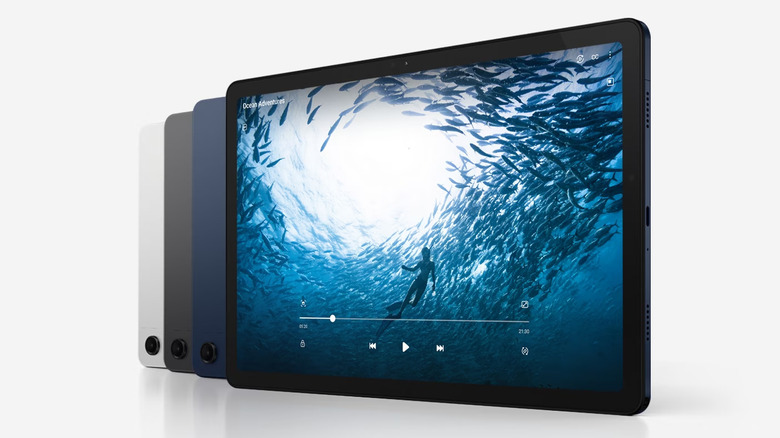Every Samsung Galaxy Tablet Released In Chronological Order
We may receive a commission on purchases made from links.
The very first iPad was announced in January of 2010, and then later in September of the same year, Samsung announced its first tablet: the Galaxy Tab 7.0 (via Wired). So right off the bat, Samsung had some pretty difficult tablet competition with Apple, a brand well known at the time (and today) for its smart touchscreen displays. Compared to what Samsung's tablets offer today, the original Galaxy Tab pales in comparison, but it's fascinating to look back at the company's original design and see how much its tablets have improved.
Since the first Galaxy Tab, Samsung tablets have seen improvements to their internal specs, like more RAM and internal memory, greater amounts of expandable storage, a much clearer and more vivid display, and of course, stronger and more efficient processors. Samsung has also introduced quite a few newer tablets that have LTE or 5G capability, allowing you to use it more like a cellphone and integrate it completely with your Galaxy smartphone or Galaxy watch.
Samsung Galaxy Tab - 2010/2011
Samsung's first foray into the world of tablets was with the Galaxy Tab. One of the first competitors to Apple's iPad, the Galaxy Tab was released in 2010 with a pretty decent reception. At the time of its original release, the Galaxy Tab was only available with a 7-inch screen. This smaller screen was more comparable with the Amazon Kindle than the 9.7-inch iPad.
Although a lot of people favor large screens, the 7-inch screen on the Galaxy Tab's first model (and subsequent models) is the perfect form factor for one-handed use. The small screen has a resolution of 600 x 1024 pixels, which isn't super impressive, but awesome display specs were hard to find in 2010.
Samsung's Galaxy Tab was originally released with a 1GHz A8 Cortex processor, 16GB of internal memory storage and the option for a 32GB microSD card, and a 4000mAh battery. You could use Bluetooth 2.1 to connect headphones or a keyboard, and connect to Wi-Fi 802.aa a/b/g/n to browse the internet, stream videos, or play games. There's only one USB 2.0 port on the tablet, and that port is only able to charge the device through a wall outlet. It's also worth mentioning that a selfie camera was included, but it's a 2MP camera that records in 720p at 30 frames per second.
Between 2010 and 2011, Samsung released a few other versions of the original Galaxy Tab that mainly differed in screen size.
Samsung Galaxy Tab 2 - 2012
Although Samsung first released the 7-inch model of the Galaxy Tab 2 in 2012, it was the 10.1-inch model that won the public's favor. Compared to its biggest competition, the iPad from Apple, the 10.1-inch Galaxy Tab 2 provided an affordable tablet alternative that didn't skimp on screen size. At 1280 x 800 pixels, the resolution improved slightly from the previous model but still wasn't anything special.
A lot of the specs stayed the same between the original Tab and the Tab 2, like the 16GB of internal memory storage (with an option to expand storage with a 32GB microSD card), Wi-Fi capabilities, the 1.0GHz processor, and the 4000mAh battery. On the 7-inch model of Tab 2, the resolution stayed at 600 x 1024 pixels.
The two biggest differences between the two models are the cameras and Bluetooth capabilities. The original Tab only supports Bluetooth 2.0, but Tab 2 supports Bluetooth 3.0. Then, the 2MP camera on the Tab was upgraded to a 3MP camera on the Tab 2.
Samsung Galaxy Tab 3 - 2013/2014
With the 3rd Galaxy Tab model, Samsung released another 7-inch version, but this wasn't the version that took off. Instead, the 8-inch model became a fan favorite with its 1280 x 800 pixel resolution. This was yet again a fairly affordable tablet compared to the other options currently on the market in 2013.
The Tab 3 was the first Samsung tablet to have 1.5GB of dedicated DDR2 SDRAM and a 16GB internal hard drive. You could also expand storage with a microSD card up to 64GB. Then, the CPU also got a slight upgrade; the Tab 3 boasted a 1.2GHz quad-core processor and ran Android 4.2 Jelly Bean. The 5MP rear camera was also fairly impressive for a tablet in 2013.
In addition to a 7-inch model and an 8-inch model, Samsung also released a 10.1-inch Tab 3 as well as a Lite 7.0-inch Tab 3.
Samsung Galaxy Note - 2013/2014
Samsung deviated from its Tab series with the first Galaxy Note tablet. The 8-inch version of the Galaxy Note tablet came with a 1280 x 800 screen resolution and a service called WatchON that would search the internet, YouTube, or your device for the video content you're trying to find. Then, if you have a Samsung Smart TV that's at least a 2013 model, you can even pass off live TV from your TV to your tablet.
Inside, there's a 1.6GHz Exynos_4400 quad-core processor and 2GB of DDR3 SDRAM that helps everything feel a lot smoother than previous Galaxy tablets, from browsing the internet to playing mobile games to making a video call. There's also 16GB of flash memory built-in, but you can add up to 64GB of extra storage with a microSD card.
The first Galaxy Note tablet's cameras weren't an improvement from the Galaxy Tab 3. These two tablets are technically different series, but the Note tablet did release after the Tab 3. There was a 5MP rear camera, and a 1.3MP front camera for selfies or video calls. With all other specs, however, the Note was a step up from the Tab 3.
Samsung Galaxy Note Pro - 2014
The Galaxy Note Pro is by far the largest and most impressive tablet Samsung had released up to this point. It has a stunning 2560 x 1600 resolution and a large 12.2-inch screen, making video streaming or even just working on the tablet more enjoyable. The Note Pro is actually so popular that it's still available to buy new from Samsung and other retailers, despite launching eight years ago.
The Note Pro certainly has a beautiful display, but its other specs are just as impressive. It has two different processors working together, a 1.9GHz quad-core processor and a 1.3GHz quad-core processor. Then, you'll find 3GB of RAM and either 32 or 64GB of internal memory storage, with the option to expand external memory with a 64GB microSD card. The battery also got a massive upgrade to a 9500mAh capacity.
The 2MP front camera and 8MP rear camera are still far from crisp, but these were the best cameras on a Samsung Galaxy tablet at this point in time. And like the previous Note model, the Note Pro supports Bluetooth 4.0 as well as Wi-Fi 802.11 a/b/g/n/ac (2.4GHz and 5GHz).
Samsung Galaxy Tab 4 - 2014
One of the biggest upgrades between the Galaxy Tab 3 and the Tab 4 was the operating system. The Galaxy Tab 4 is equipped to run Android 4.4.2 (KitKat) with its quad-core 1.2GHz processor. This was also the first Galaxy Tab to support Bluetooth version 4.0 (via GSMArena). This gave the device superior sound when using headphones, making activities like movie watching and music streaming more enjoyable.
Other than these two changes, a lot of the specs and features stayed the same between Tab 3 and Tab 4. It has a 1280 x 800 screen resolution, 16GB of flash memory, and the option to expand with a 64GB microSD card, a 4000mAh battery, and the same cameras.
Like the other Tab models, the Tab 4 was released with a few different size options. Available were options including a Tab 4 with a 7-inch screen, 8-inch screen, or 10.1-inch screen.
Samsung Galaxy Tab S - 2014
This is the first tablet in Samsung's high-end Galaxy Tab S line, and it doesn't disappoint. Its 8.4-inch screen is larger than most previous Galaxy tablets, which typically come with a 7-inch or 8-inch option. Even the larger 10.5-inch screen option for the Tab S is an upgrade from the 10.1-inch screen options you'd see in other tablets.
Aside from being slightly larger, the Tab S comes with a stunning AMOLED display with 2560 x 1600 resolution. Then, there's 3GB of RAM, 16GB of flash memory with an option to expand storage up to 128GB with a microSD card, and a battery capacity of 4900mAh.
Similar to the Note Pro, the Tab S has two quad-core processors (1.9GHz and 1.3GHz) working together in the Exynos 5420 Octa chip. This tablet comes with Android 4.4.2 (KitKat), but can be upgraded up to Android 6.0 (Marshmallow). The 2.1MP front camera isn't much of an upgrade from the Note Pro, but the 8MP rear camera gained an LED flash feature. A few other notable features on the Tab S include a fingerprint scanner for security and SideSync 3.0, which lets you view your smartphone screen on your tablet screen.
Galaxy Tab Active - 2014
Tablets are fairly handy in an enterprise sense. They allow users to handle a variety of office tasks, such as sending emails and working on documents. Specialist apps are also available that can perfectly adapt a tablet to meet the needs of a particular role. Unfortunately, the easy-to-use devices are quite fragile. Samsung has attempted to fix this with the Galaxy Tab Active — a more robust version of the standard tablets designed for use out in the field.
That said, the Galaxy Tab Active isn't strictly enterprise, anyone can buy one. Still, its target customer base includes the likes of first responders, construction workers, mechanics, people working outdoors, and anyone else operating in an environment where a standard tablet would be handy but may not survive.
So far, Samsung has made the original Galaxy Tab Active, along with its LTE version, a Galaxy Tab Active 2, Galaxy Tab Active Pro, Galaxy Pad Active3, and Galaxy Tab Active4 Pro. Under the hood, the tablets are largely the same as the standard version, with a few exceptions, as some models have a few useful tweaks beyond the added durability. On the Galaxy Tab Active4 Pro, for example, the touchscreen is designed so users wearing gloves can navigate it while the batteries are heavier duty and easily replaceable, and there are customizable hotkeys that allow the Active4 Pro to double as a walkie-talkie.
Samsung Galaxy Tab Pro - 2014/2016
The Galaxy Tab Pro from Samsung saw another CPU upgrade with the 1.9GHz Samsung Exynos Octa processor. The 12.2-inch screen with a 2560 x 1600 resolution is almost identical to the Note Pro's 12.2-inch screen, the only difference being LED vs AMOLED tech.
It's powered by a 9500mAh battery and comes with 3GB of RAM and 32GB of flash memory, with the option to insert a 64GB microSD card for extra storage. The Tab Pro's 12.2-inch model also lets you use the Multi Window feature with up to four different applications pulled up at once, side by side.
In this same line of tablets, the Tab Pro S was released. The Tab Pro S is more like a mini PC, in both design and specs. Inside, it has a 12.2-inch AMOLED screen, an Intel Core m3 CPU, a 128GB SSD, 4GB of RAM, and runs Windows 10 OS. Visually, this is the first Samsung tablet to come with a keyboard cover that allows you to use the tablet more like a small laptop.
Samsung Galaxy Tab E - 2014/2016
In addition to an S line of tablets, Samsung also released an E line, which is meant to be an entry-level line that's more affordable. While there have been different sizes of the Tab E released between 2014 and 2016, this is the only tablet in Samsung's E line, with the 9.6-inch model being the most popular.
The 9.6-inch model has a 1280 x 800 screen resolution, 1.5GB of RAM, 16GB of flash memory and a microSD card slot for expandable storage up to 400GB. The 1.2GHz quad-core Qualcomm APQ 8016 processor powers Android OS up to version 5.1 (Lollipop). Although it doesn't have the largest battery capacity among Samsung's tablets, the Tab E has a 7300mAh battery, which is larger than a lot of Samsung's previous models that only had battery capacities of around 4000mAh.
There's a 2MP front-facing camera and a 5MP rear camera with autofocus. Although the cameras themselves aren't anything special on the Tab E, this tablet did come with a few special photo and video features. You can use Panorama mode to capture an entire scene from left to right, or use Continuous Shot mode to snap multiple photos one after the other.
Samsung Galaxy Tab S2 - 2015
For people who love to stream videos on their tablets, Samsung's Galaxy Tab S2 was a fantastic option in 2015. The Tab S2 has an 8-inch model and a 9.7-inch model, both of which have a Super AMOLED display with 2048 x 1536 resolution. This, paired with video streaming capabilities of 4K resolution at 30 frames per second, makes watching videos a very enjoyable experience.
Inside, the octa-core processor is made up of two quad-core processors (1.8GHz and 1.4GHz). There's 32GB of RAM, 30GB of flash memory, and up to 400GB of possible external storage with a microSD card. Then, similar to the Tab S, there's an integrated fingerprint scanner which makes unlocking the tablet and certain applications a breeze.
Unfortunately, even though this model is newer than the previous models mentioned in this list, the Tab S2 only has a 4000mAh battery. While this isn't a horrible battery size, it's a lot smaller than the most recent tablets Samsung had been releasing at the time.
Samsung Galaxy Tab A - 2015/2020
This is the first of Samsung's A tablet line of products. The A tablets are designed to be mid-range, somewhere between the E line and the S line. The original 8-inch Tab A was released in 2015, then updated in 2017, 2018, and 2019. You can also find a 10.5-inch model and a 10.1-inch model of Tab A. Then, most recently, Samsung released an 8.4-inch model in 2020 exclusively for T-Mobile customers that has 4G LTE capability.
The 2019 Tab A has a 5100mAh battery that boasts about 13 hours' worth of battery life. Then, there's 2GB of RAM, 32GB of built-in memory, and up to 512GB of expandable storage via a microSD card. Although the tablet might come with Android 8.0 (Oreo) or 9.0 (Pie), you can upgrade it to Android 10.
This model seems to be better than other Samsung tablets in some aspects, like storage capability, battery capacity, and even its 8MP rear camera with an autofocus feature. It also has a 2.0GHz quad-core Qualcomm Snapdragon 429 processor. While the resolution isn't as high as other Samsung tablets, Tab A's 1280 x 800 resolution is nothing to sneeze at.
Samsung Galaxy Tab S3 - 2017
Samsung truly stepped up its game with the Galaxy Tab S3. From the gorgeous display to upgraded cameras to impressive specs, this is an amazing tablet. It comes with Android 7.0 (Nougat), though you can upgrade it to Android 9.0 (Pie).
The 9.7-inch screen has a 2048 x 1536 resolution and a Super AMOLED display that's HDR-ready. You can expect vivid colors and deep blacks on this thing. Another neat new feature for the Tab S3 is something called Quad speakers; there's a speaker in each of the tablet's four corners and the speakers intuitively move with what's currently playing on your screen.
Inside, there's a 2.2 GHz Snapdragon 820 quad-core processor, 4GB of RAM, 32GB of flash memory, up to 400GB of expandable storage with the purchase of a microSD card, and the Adreno 530 graphics coprocessor. To help battery life keep up with all the powerful internals, there's a 6000mAh battery with USB Type-C charging that brings the tablet to a full charge in only three hours.
When it was released in 2017, the Galaxy Tab S3 had the most impressive cameras of any Samsung tablet. The front-facing camera for selfies and video calls is 5MP, and the rear camera is 13MP and has flash capability. You're also able to record video in 4K resolution at 30 frames per second.
With the Tab S3, there's also a detachable keyboard you can purchase separately to make it more of a mini laptop. Then, you also get an S Pen for free to use on the touchscreen.
Samsung Galaxy Tab S4 - 2018
Only a year later, the Galaxy Tab S4 launched and it was even more impressive than the Tab S3. Compared to the Tab S3, the Tab S4's 10.5-inch screen is larger and has an even more impressive Super AMOLED 2560 x 1600 resolution. Then, this is the first Samsung tablet to incorporate Dolby Atmos Surround Sound for a more cinematic sound experience. There are also built-in microphones that support Google Assistant and listen for your voice even if you're far from your tablet.
There's a 2.35GHz octa-core Qualcomm processor that supports Bluetooth 5.0 and Android 8.0 (Oreo) right out of the box, but the Tab S4 can upgrade to Android 10. Then, there's also 4GB of dedicated RAM, 64GB or 256GB of internal flash memory, and up to 400GB of external storage through the purchase of a microSD card. Even the battery capacity got a boost to 7300mAh, so the tablet lasts even longer in between charges.
The Tab S4 has quality cameras that come with a few special features. There's an 8MP front-facing camera and a 13MP rear-facing camera, making the Tab S4 home to Samsung's best tablet cameras as of 2018. The front-facing camera can recognize your face and scan your irises to unlock your tablet. Then, with Bixby Vision 2.0, you can use your camera app to help translate something, identify a location, or find a product to buy online.
Samsung Galaxy Tab S5e - 2019
One of the most unique features of Samsung's Galaxy Tab S5e is how thin and lightweight it is. This tablet weighs less than a pound and was Samsung's slimmest tablet as of 2019, making it the perfect travel companion to school or work.
The battery capacity dropped to 7040mAh, down from 7300mAh from the Tab S4, but still boasts an impressive 15-hour battery life. Out of the box, the Tab S5e comes with Android 9 (Pie) but it can upgrade to Android 11. And instead of giving voice commands to the built-in Google Assistant, you'll give commands to Samsung's own virtual assistant, Bixby.
Other than those few things, not a lot changed between the Tab S4 and the Tab S5e. It still has a vivid 10.5-inch Super AMOLED display with a 2560 x 1600 resolution, 4GB of RAM, Dolby Atmos audio tuned by AKG, and the same awesome front- and rear-facing cameras.
There are two customizable options for RAM and flash memory unique to the S5e. You can choose 4GB of RAM and 64GB of flash memory, or 6GB of RAM and 128GB of flash memory. With both options, you can add an extra 512GB of external storage with a microSD card.
Samsung Galaxy Tab S6 (Lite) - 2019
It's always great to see a company consistently improving its next-gen product and not just slapping a new price tag on something that's identical to last-gen. Both the Tab S6 and the Tab S6 Lite were released around the same time as the S5e, so they share a few features but are different enough to warrant a new numbered title.
Just like the Tab S5e, the Tab S6 weighs less than a pound and the S6 Lite barely weighs over a pound. They also both support cellular LTE, Wi-Fi, and Bluetooth 5.0. Then, they both have an awesome battery life, but the Tab S6's battery can last about five hours longer than that of the S6 Lite.
The Tab S6 is clearly the more powerful of the two models, while the Tab S6 Lite is a more affordable option that still packs quite a punch. Most notably, the S6 has a 10.5-inch Super AMOLED display and a Qualcomm 855 octa-core processor. The S6 Lite, on the other hand, has a 10.4-inch TFT LCD screen and an Exynos 9611 octa-core processor.
With the Tab S6, there's 6GB of RAM, 128GB of internal memory, and an external capacity of 1TB via a microSD card. With the Tab S6 Lite, you can pair 4GB of RAM with 64GB or 128GB of internal memory, or spring for 6GB of RAM and 128GB of internal memory; you also have that same external storage option of a 1TB microSD card.
Samsung Galaxy Tab S7 - 2020
Released in 2020, the Samsung Galaxy Tab S7 was bigger and better than the Tab S6. All tablets in the 7 series support Wi-Fi 6 and Bluetooth 5.0, have model options that include 5G or LTE capability, and come with an improved S Pen version with 9ms latency. The S7 has an 11-inch TFT display that maxes out at a 120Hz refresh rate, but if you want an even better display, the S7+ comes with a 12.4-inch Super AMOLED display that also maxes out at 120Hz.
With quad speakers that feature Dolby Atmos Surround Sound, a Qualcomm SDM865+ processor, and a 120Hz refresh rate, this is the first Samsung tablet that was marketed as a gaming tablet. Marketing materials mention connecting a Bluetooth controller with ease and running intense games with minimal lag. The S7 FE has a different processor: the Qualcomm SM7325.
All models also have customizable options when it comes to the amount of RAM and flash memory. Both the Tab S7 and S7+ offer combinations of 6GB of RAM and 128GB of storage, or 8GB of RAM and either 256GB or 512GB of storage. Then, even though this is already the most internal storage a Samsung tablet has ever offered, you can add extra storage with a microSD card up to 1TB. Then, the S7 has a fairly large 8000mAh battery, but the S7+ and S7 FE are equipped with an even larger 10090mAh battery.
Samsung Galaxy Tab A7 - 2020
Unlike other Tab A models, this is the first version to get a number attached to its title. Similarly titled after the S7 series released at the same time, the Tab A7 is an affordable tablet with a large display. Instead of offering various screen size options to customers, the Tab A7 only offers a 10.4-inch ultra-wide display with a 2000 x 1200 pixel resolution.
As with many later tablet models from Samsung, the Tab A7 is equipped with a quad-speaker system with Dolby Atmos Surround Sound. Inside, there's 3GB of RAM, an Exynos 9611 processor, a Qualcomm SDM865+ graphics coprocessor, a 7040mAh battery, and an option of 32GB or 64GB of internal memory. If you want extra memory, you can always buy a microSD card and add up to 1TB of additional storage.
A year later, Samsung released the A7 Lite for those who were okay with a smaller 8.7-inch display in exchange for saving quite a bit of money. The A7 model only offers a Wi-Fi version, but the A7 Lite lets you choose between a Wi-Fi-only model or an LTE version through a mobile carrier like AT&T, Verizon, or T-Mobile.
Samsung Galaxy Tab S8 - 2021
The Galaxy Tab S8 series is the best Samsung currently has to offer in the world of tablets. All three models come with the Qualcomm Snapdragon 8 Gen 1 chipset, WiFi 6E support, Bluetooth 5.2, and a silky 120Hz refresh rate. The only difference between displays is size and the slightly lower quality on the Tab S8. The S8 has an 11-inch TFT LCD display with a 2560 x 1600 resolution, whereas the 12.4-inch S8+ and 14.6-inch S8 Ultra have Super AMOLED displays.
The S8+ has 5G capability through your carrier, and the S8 has an LTE/Wi-Fi version for AT&T or Verizon. Both the S8 and S8+ offer 8GB of RAM and a choice of either 128GB or 256GB of internal memory; the S8 Ultra, however, offers 12GB and even 16GB of RAM paired with 256GB and 512GB of internal memory, respectively.
All models also come with the latest S Pen, which boasts almost zero latency and can magnetically attach to the back of your tablet to charge. The Tab S8 series also introduces a great ultra-wide 6MP rear camera in addition to a stunning 13MP rear camera with autofocus. Then, with the upgraded 12MP front camera, you'll look super crisp in selfies and on video calls.
Samsung Galaxy Tab A8 - 2022
The Galaxy Tab A8 is Samsung's newest tablet to date. Unlike the previous A7 model, you have more options with the Tab A8 when it comes to amounts of RAM and internal storage. You can pair 3GB of RAM with 32GB of flash memory or pair 4GB of RAM with either 64GB or 128GB of flash memory. These internal storage amounts are still tiny in comparison to Samsung's more premium S line, but you can add up to 1TB of external storage with a microSD card.
Because this is a more affordable model, the 10.5-inch TFT LCD display only has a 1920 x 1200. This certainly isn't a bad resolution, but it's worse than the S tablet's Super AMOLED display and higher resolution. Inside, there's an octa-core Unisoc T618 processor and four powerful speakers fueled by Dolby Atmos, making streaming videos and even gaming a breeze. Plus, with its 7040mAh battery, you'll be able to go one or two days in between charges.
One of the best features of the Tab A8 is its ability to connect multiple Galaxy devices. Almost everything between your Galaxy devices syncs automatically, like writing your to-do lists, answering and transferring phone calls, or switching a song from playing on your tablet to your smartphone. So if you're someone who has a Galaxy smartphone or watch, you'll be able to take advantage of the A8's multi-tasking capabilities.
Galaxy Tab S9 - 2023
Samsung's latest flagship tablet is the Galaxy Tab S9, which launched in August of 2023. The premium device has a premium price tag and will set you back up nearly $1,500 if you opt for the Ultra and 1TB of internal storage. Its price and features mean the Galaxy Tab S9 is going head-to-head with the iPad. Despite Apple having the edge in the tablet market for a long time, the Galaxy Tab S9 does come with a number of features that may make it the more attractive option.
These features include a larger display and aspect ratio, IP68 water and dust proofing, and vision-boosting technology that makes it more viewable in harsh sunlight. Its cooling system has also received a boost, with the S9 being the first tablet in Samsung's lineup to use vapor chamber technology to drop the device's temperature.
Under the hood, there's a Qualcomm SM8550-AC Snapdragon 8 Gen 2 chipset featuring an octa-core processor and either eight or 12GB of RAM. That processor is capable of speeds of up to 3.36 GHz, and there's a 13MP main camera and a 12MP selfie camera, both capable of shooting 4K video. The Galaxy Tab S9 also has a Micro SD slot so that storage can be expanded even further.
Galaxy Tab A9 - 2023
As with previous generations, the Galaxy Tab S9 has a cheaper and more accessible little brother in the Galaxy Tab A9. The A9 is likely to appeal to those on a budget, especially for users who don't need all of the power and features that come with Samsung's flagship tablet.
There are two options with the A9, a regular version with an 8.7-inch screen and the 11-inch A9+. Both devices come with 8GB of RAM and 128GB of storage built into the tablet. That storage can be increased by up to 1TB if you add in a Micro SD card. For connectivity, 5G comes standard with the tablet, along with other common connectivity options like Wi-Fi and Bluetooth. Some of Samsung's software stalwarts, like the ability to split the screen and a Knox-encrypted secure folder, are also included.
The 8MP main and 2MP selfie cameras are likely to be somewhat disappointing, especially compared to the cameras Samsung puts in its lower to mid-range phones these days. The processor is octa-core, so will be handy for multitasking. However, its actual speed, 2.2GHz or 1.8GHz, depends on the exact chip used in your region's devices. Overall, the Galaxy Tab 9 has some solid features on paper, along with the compromises you would expect from a newly launched device that many retailers are selling at around the $250 mark.

